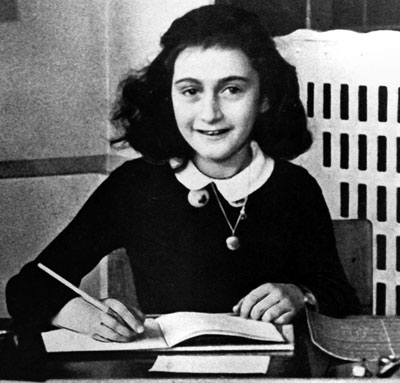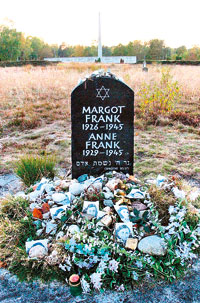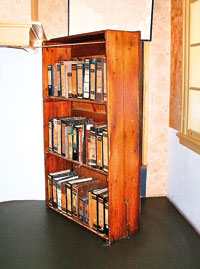A young girl’s hopes and frustrations in a feuding world
View(s):In our new series,”Her Courage”, about women who faced extermination, written as a tribute to poet Anne Ranasinghe, Gérard Robuchon this week writes on Anne Frank

The schoolgirl Anne Frank
“Dear Kitty, I’m known as a bundle of contradictions. As I’ve told you several times, my soul is split in two. On one side, my exuberant cheerfulness, my mocking approach to everything, my joy in life and my ability to take things lightly. By that, I mean not seeing any wrong in flirting, giving a kiss, embracing someone, or telling a tasteless joke. That side lies in wait, pushing back the other side which is more beautiful, purer and deeper. The truth is that no one knows Anne’s better side and that’s why most people can’t stand me. I can be an amusing clown for an afternoon, but then everyone has had enough of me. So the nice Anne has never once been seen in company. But, in her loneliness, she always triumphs. Yours. Anne Frank.” (Anne’s diary ends here.)
Anne Frank and her family were arrested by the Nazis on August 4, 1944 – after two years hiding in the rear rooms of a house in Amsterdam, Holland being occupied by the German army. She was 15. She did not survive extermination. Anne Frank was born a German Jew from Frankfurt. Her father was a businessman. The family had moved to Holland soon after Hitler’s taking over in Germany. Dutch was Anne’s schooling language – a language which she loved.
The big diary left behind by the little Anne Frank became one of the 20th century world’s most famous literary masterpieces. “You’ve known for a long time, she wrote, that my greatest wish is to become a journalist some day and later on a famous writer.” (May 11, 1944) This is a tragic narrative, set in Holland during World War II. It relates the day to day fears and expectations, permanently on the verge of culminating with the final horror – that of the Final Solution decreed by the Nazis: racial extermination, human extermination.

The Anne Frank memorial at Bergen Belsen
A prescribed text in schools, The Diary of a Young Girl is the paragon of a teenager’s writing, consequently the paragon of the teenagers’ reading. To exemplify this, let us recall the French movie The Class (Entre les murs, 2008) which won the Palme d’Or at the Cannes Festival: the French teacher requests his students in a multicultural classroom to read aloud some pages of the Diary, so that they could learn from a peer things about tragic events happening in the outer world as well as what is in the mind of a very, very ordinary schoolgirl, during her physical, intellectual, growing-up years. “When I read the Diary,” said the teacher, “I learn about Anne Frank because she talks about herself and so I get to know her. Now when I ask you to write your self-portraits, I’ll expect the same. In other words, I hope to learn things through your feelings. You can also talk about facts that will allow me to get to know you better.”
The everlasting relevance of Anne Frank’s diary lies in the fact that it addresses all readers, because of any one of the issues dealt with. These issues are mainly of three kinds: the inner feelings of an adolescent with her joys and frustrations; the difficulty and deception while facing family brawls or adults’ feuds; the growing war in Europe and its immediate effects in Holland. “I have often been downcast, but never in despair; I regard our hiding as a dangerous adventure, romantic and interesting at the same time. I am young and I possess many buried qualities; I am young and strong and am living a great adventure; I am still in the midst of it and can’t grumble the whole day long. I have been given a lot, a happy nature, a great deal of cheerfulness and strength. Every day I feel that I am developing inwardly, that liberation is drawing nearer and how beautiful nature is, how good the people are.” (May 3, 1944). She reads Dutch novels and she finds solace in learning French.
The main reason that makes the Diary so appealing is the succession of day-to- day thoughts of a teenager mutating – with her vexations, her contradictions, her changes of mind, her practical search for goodness and forgiveness – all but human. “I think what is happening to me is so wonderful, and not only what can be seen on my body, but all that is taking place inside. I never discuss myself or any of these things with anybody; that is why I have to talk to myself about them.” (January 5, 1944.) Anne transcends the horror of war : “I don’t think then of all the misery, but of the beauty that still remains. Whoever is happy will make the others happy too. He who has courage and faith will never perish in misery.” (March 7, 1944)

Anne Frank’s house now a museum
She strives to unveil her inner strength. “Although I’m only fourteen, I know quite well what I want, I know who is right and who is wrong, I have my opinions, my own ideas and principles, and although it may sound pretty mad from an adolescent, I feel more of an adult than a child.” (March 17, 1944)
The other interesting aspect of the diary is the day-to-day view of the evolution of the war: the dramatic spectacle offered to Anne from her window upstairs (bombings, shootings, arrests of Jews…), the news about the concentration camps and the gas chambers, the early awareness of the project of the Germans. With Anne Frank we long for peace, which is to be brought by the victory of the Allies, namely the British forces expected to land in Holland at any time.
“After I came here when I was just fourteen, I began to think about myself sooner than most girls.” (January 5, 1944) “Since I’ve been here, from July 1942 until a few weeks ago, I can assure you that I haven’t had any easy time. You can’t and mustn’t regard me as fourteen, for all these troubles have made me older.” (May 5, 1944) Between hate and hope, Anne Frank learns – through a formidable self-learning process – how to get ready for the worst option, but also how to convert hate into hope. Several times she complains that the adults consider her still as a silly little girl. Often she wishes to slap one of those adults in the face, including her parents… It is true that diary-writing is the most confidential exercise – if no room is made for self-lies. After a stroke of genius, Anne had decided to address each entry in her diary to an imaginary friend or confidant, whom she christened Kitty. And now she told all the truth, but only the truth to that ‘Kitty’.
“Would anyone, either Jew or non-Jew, understand this about me, that I am simply a young girl badly in need of some rollicking fun.” (December 24, 1943)
Once betrayed and arrested, Anne Frank and her sister were sent to the concentration camp of Bergen-Belsen in Germany. There they probably died from typhus in October 1944 in the great anonymity of the Nazi mass extermination system. That was some four months after the landing in Europe (in Normandy, France) of the Allied forces from UK and USA and at the height of the Final Solution. Anne Frank’s diary was retrieved by one of her family’s protectors, when she arrived at the Annex building after the arrest and the sack of the rooms.
The Diary of a Young Girl was first published in 1947 by Anne’s father Otto Frank, the only survivor of the Frank family. Otto Frank died in 1980, aged 91. All his life he strove for Anne’s memory to be revived. Anne had written, “I want to go on living even after my death! And therefore I am grateful to God for giving me this gift, this possibility of developing myself and of writing, of expressing all that is in me.” (April 4, 1944)
The Anne Frank Museum in Amsterdam was set up in the building where Anne Frank lived those two years in hiding with her family: it is now one of the most visited museums in Holland.
(Dr. Gerard Robuchon is Director, Alliance Francaise de Jaffna)


